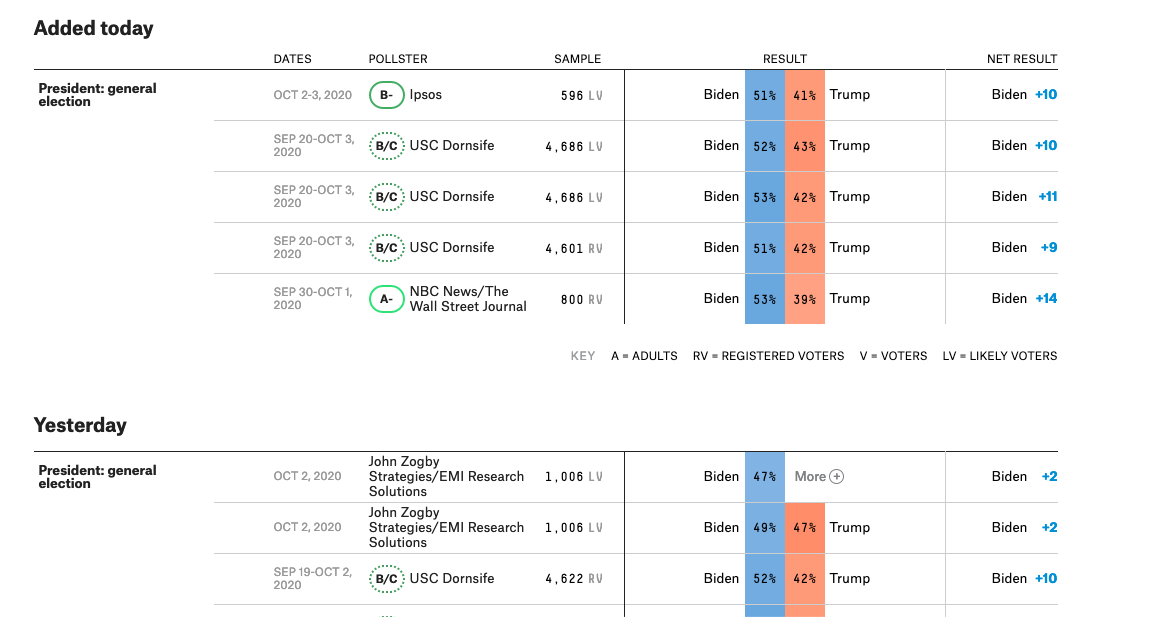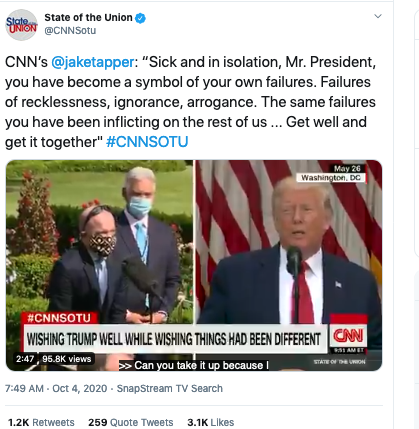New questions emerge about timing and severity of President Trump’s coronavirus infection
White House officials and doctors stoked new questions Saturday about how sick President Trump has been with COVID-19 and when he became ill, as the president’s medical team suggested Trump had been sick for a day and a half before he announced his infection early Friday morning.
The new timeline, if accurate, would mean Trump held a rally and fundraiser in Minnesota on Wednesday and an intimate fundraiser in New Jersey on Thursday while knowing he was sick, potentially exposing supporters, employees and others to the coronavirus.
The White House quickly attempted to walk back some of the doctors’ comments, claiming Trump was diagnosed Thursday evening, not earlier as the medical team had indicated at a Saturday briefing at Walter Reed National Military Medical Center, where he is being treated.
However, others in Trump’s circle confirmed Trump had been considerably sicker than previously announced, enough so that he required supplemental oxygen on Friday morning after laboring to breathe.
The contradictions and the administration’s long record of providing false or opaque information fueled mounting confusion about Trump’s illness and whether he is in real danger.
“He’s the president, and the country has a right to know. I’d like to see more information,” said Dr. Ashish Jha, dean of the Brown University School of Public Health.
At the Walter Reed briefing, Dr. Sean Conley, the president’s physician, and other doctors pronounced themselves “cautiously optimistic” about Trump’s health. They said his breathing was normal and his fever was resolving.
A few minutes later, however, White House Chief of Staff Mark Meadows offered a dimmer assessment to White House reporters.
“The president’s vitals over the last 24 hours were very concerning and the next 48 hours will be critical in terms of his care,” Meadows said. “We’re still not on a clear path to a full recovery.”
Conley was evasive about whether the president had needed supplemental oxygen, declining to say unequivocally that Trump had not received it.
“Right now, all indicators are that he’ll remain off of oxygen going forward,” Conley said.
Under questioning from reporters about whether the president had needed oxygen over the previous three days, Conley seemed to rule out every period except early Friday, before Trump was abruptly taken to Walter Reed.
A person familiar with Trump’s recent treatment later confirmed that he received supplemental oxygen Friday morning after laboring to breathe, raising the level of alarm among White House officials.
Several of the doctors and nurses who stood with Conley outside Walter Reed work in critical-care pulmonology as specialists in respiratory complications that can occur in severe cases of COVID-19.
The White House press office did not respond to questions later Saturday about the president’s use of oxygen.
At the briefing, Conley also declined to say what Trump’s temperature had been when he had a fever, saying only that he’d been fever-free for 24 hours. And the White House physician wouldn’t reveal when Trump last had a negative coronavirus test.
Adding to the confusion, Dr. Brian Garibaldi, a Johns Hopkins pulmonologist who is working with the White House medical team, said Saturday that Trump had received a dose of an experimental antibody therapy “about 48 hours ago,” which would have been around midday Thursday.
That would mean Trump received the treatment some 12 hours before he announced his positive test and before learning that his advisor Hope Hicks had tested positive for the virus.
The drug, made by the pharmaceutical company Regeneron, hasn’t been approved for COVID-19 treatment but was provided under the Food and Drug Administration’s “compassionate use” program, which is typically reserved for critically ill patients who are willing to try almost anything.
Conley and his team tried to give an upbeat assessment of Trump’s current condition, with one physician saying that Trump told his doctors Saturday morning, “I feel like I could walk out of here today.”
“The team and I are extremely happy with the progress the president has made,” Conley said.
Saturday evening, Trump posted a four-minute video of himself seated at a table in the hospital, thanking his caregivers and assuring Americans that he would return to work and the campaign trail.
“I came here — wasn’t feeling so well — I feel much better now,” Trump said, speaking hoarsely and somewhat haltingly.
“I just want to tell you that I’m starting to feel good. You don’t know, over the next period of a few days, I guess that’s the real test, so we’ll be seeing what happens,” he added.
In a memo released by the White House on Saturday night, Conley reported “substantial progress since diagnosis,” calling Trump free of fevers and “off supplemental oxygen.”
The doctor said the president had taken his second dose of remdesivir, an antiviral medication he began taking Friday, and had been conducting business and moving around his medical suite.
“While not yet out of the woods, the team remains cautiously optimistic,” Conley wrote.
As Trump’s allies rallied to project a sense of calm, Senate Majority Leader Mitch McConnell (R-Ky.) tweeted that he’d had a “great call” with him, discussing topics including the Supreme Court vacancy and the economy. “He sounds well and says he’s feeling good,” McConnell wrote.
Underscoring the mounting toll the coronavirus is taking on official Washington, Wisconsin Sen. Ron Johnson on Saturday became the third Republican senator to announce a positive coronavirus test.
Former New Jersey Gov. Chris Christie, a Republican and confidant of the president who said no one wore masks when he and others spent several days preparing Trump for last Tuesday’s presidential debate, also announced Saturday that he had tested positive and said he had admitted himself to a New Jersey hospital.
The president is expected to spend at least several days in the hospital.
The abruptness of his departure from the White House on Friday and the fact that he was put on an experimental drug regimen have caused concern among outside physicians and specialists.
“The way they’ve treated him so far, they’ve been pretty aggressive,” Brown University’s Jha said. “In a typical patient, you’d look at that and say, these are all really concerning signs. With him, we have to read it a little different.”
But as a 74-year-old man who is obese, Trump faces an elevated risk.
“The fact that there’s any symptoms puts us in a whole new realm of concern,” said Dr. Jeremy Faust, an emergency physician at Brigham and Women’s Hospital in Boston and a public health expert.
“This sort of crosses a Rubicon,” putting Trump in a higher risk category of people who can develop more serious health issues, Faust said.
A White House official said Vice President Mike Pence and Second Lady Karen Pence had tested negative for the coronavirus Saturday morning.
Johnson’s diagnosis could further complicate Republicans’ effort to confirm Judge Amy Coney Barrett to the Supreme Court before the Nov. 3 election. Republicans hold a three-seat majority in the Senate, and two Republicans have already said they will not vote to confirm her before that.
At least one other Republican senator, Ben Sasse of Nebraska, said he would self-quarantine until Oct. 12 despite a negative test because he was exposed to a senator who tested positive.
South Carolina Sen. Lindsay Graham, a Republican who chairs the Senate Judiciary Committee, said he plans to start hearings on the nomination the week of Oct. 12 as previously scheduled.
Unlike other high-profile Republicans who have tested positive, Johnson did not attend an event in the Rose Garden on Sept. 26 to announce Barrett’s nomination.
The list of top Republicans who’ve been infected is fueling a sense of panic in Washington as the virus creates the type of outbreak in and around the president that has already enveloped other parts of the country.
Though the District of Columbia had only a handful of new cases last week, the White House itself has become the city’s biggest vector.
Joe Grogan, who resigned as Trump’s top domestic policy advisor in May, tweeted that the White House complex was “the most cramped, unsanitary place of business” he had worked in.
“It is a miracle it took this long for covid to hit it. I have been healthier since I left than I ever was when I worked there,” he added.
Those recently infected include Kellyanne Conway, a recently departed counselor to Trump who attended the Rose Garden event; Hicks, a senior advisor who is often with Trump; Ronna McDaniel, chairwoman of the Republican National Committee; Bill Stepien, Trump’s campaign manager; First Lady Melania Trump; Sens. Mike Lee (R-Utah) and Thom Tillis (R-N.C.), both members of the Senate Judiciary Committee; and at least three members of the White House press corps.






